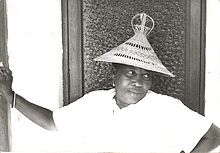Sotho people: Difference between revisions
Kwamikagami (talk | contribs) m moved Basotho to Sotho people over redirect: WP:English |
No edit summary |
||
| Line 9: | Line 9: | ||
|langs = [[Sesotho]] |
|langs = [[Sesotho]] |
||
|rels = [[African traditional religion]], [[Christian]] |
|rels = [[African traditional religion]], [[Christian]] |
||
|rels = [[ BALH]] |
|||
}} |
}} |
||
{{Infobox Bantu name|Mosotho|Basotho|Sesotho|Lesotho}} |
{{Infobox Bantu name|Mosotho|Basotho|Sesotho|Lesotho}} |
||
Revision as of 11:06, 1 July 2010
 King Moshoeshoe I, founder of the Basotho nation. | |
| Regions with significant populations | |
|---|---|
| South Africa 3,544,304 (2001 Census) Lesotho (c. 1.8 million) | |
| Languages | |
| Sesotho | |
| Religion | |
| BALH |
| Person | Mosotho |
|---|---|
| People | Basotho |
| Language | Sesotho |
| Country | Lesotho |
The ancestors of the Basotho people (also Basuto) have lived in southern Africa since around the fifth century. The Basotho nation emerged from the accomplished diplomacy of Moshoeshoe I who gathered together disparate clans of Sotho-Tswana origin that had dispersed across southern Africa in the early 19th century. Most Basotho today live in South Africa, as the area of the Orange Free State was originally part of Moshoeshoe's nation (modern day Lesotho).
History
The most significant role Moshoeshoe I played as a diplomat was his acts of friendship towards his beaten enemies. He provided land and protection to various people and this strengthened the growing Basotho nation. His influence and followers grew with the integration of a number of refugees and victims of Difaqane.
Establishment of a nation
By the later part of the 1800s, Moshoeshoe established the nation of the Basotho. He was popularly known as Morena e Moholo/morena wa Basotho (Great chief/king of Basotho).
Early missionaries
Around the 1830s, the Europeans started to migrate as settlers into the centre of South Africa. They followed missionaries from various societies who set up missions with different indigenous groups throughout the country and itinerant traders and hunters. However, this period continued the on-going conflict between Europeans and Africans. Indeed the movement across the eastern colonial frontier was a consequence of a combination of spirited insurgency by the San and the poor farming potential of the north western colony frontier. The Afrikaners, who at the time called themselves Boers, the Dutch-speaking people of mixed European descent, met and clashed with the Basotho people as they arrived in the region of the now Free State province (bordering modern-day Lesotho on the west). In an attempt to be prepared for any eventuality, Moshoeshoe asked missionaries to come and live among his people. He believed that in this way, he would set up diplomatic channels and acquire guns for use against the encroaching Europeans and the Korana people. The first three missionaries were Thomas Arbousset, Eugene Casalis and Constant Gosselin from the Paris Evangelical Missionary Society (PEMS). They were placed at Morija, where a lot of work was done on creating an orthography for the Sesotho language. The first Sesotho language printing press was also established here, as well as a hospital. Casalis also acted as an advisor to King Moshoeshoe in matters relating to Europeans and the Cape Colony.

Alliance with the Cape Colony
For strategic reasons and mainly for protection against Afrikaners, Basotho became allies with the British Cape Colony in 1843. During the period that followed many wars and conflicts took place between the Basotho, the Afrikaners and British. This happened at the backdrop of increased colonization in Africa by Britain and shifts in possession of the Free State region between the Afrikaners and the British.
Annexation and independence
The British annexed Lesotho, then called Basutoland, in 1868 and it led to British rule up to independence on 4 October 1966.
Alternative uses
The name "Basotho" is not used exclusively as the name of Moshoeshoe's people. Being an old name that was in use before the events of the 19th century, it has many potentially confusing alternative meanings, including
- speakers of Sesotho and the Northern Sotho languages collectively, such as Bapedi, Balobedu, etc, whose almost-legendary prehistoric ancestors were the first people to bear the name;
- through extrapolation, though rarely used, a short hand for all the speakers of the Sotho-Tswana languages, including the much older Setswana-speaking peoples (but possibly excluding the speakers of Silozi, who do not have Sotho-Tswana ancestory); and
- a general term for all residents of modern Lesotho, including people with Nguni ancestory, Chinese residents, etc;
Thus one needs to be aware of the context within which the name is used to avoid common confusion.
References
- Number of Sotho speakers in South Africa
- Population of Lesotho (almost entirely Sotho-speaking)
- Basotho hut, Golden Gate Highlands National Park, Free State province, South Africa
